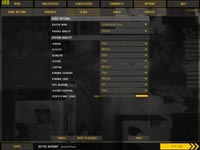
Battlefield 2
Publisher: Electronic ArtsWe are using the newly released follow up to Battlefield 1942 and Battlefield: Vietnam, Battlefield 2. It features an all-new game engine based on the DirectX 9.0 API. There is no Shader Model 3.0 support, but the majority of hardware will use a Shader Model 2.0++ mode that includes support for Normal Maps, Parallax Mapping, Full-Resolution Dynamic Shadowing, Post Processing and Fog.
The game will look the same on both NVIDIA and ATI hardware, so there is no advantage of choosing one over the other in image quality related circumstances. The only major difference is that Ultra Shadow 2 is utilised on NVIDIA's hardware, while the Shadowing on ATI hardware is done using a slightly different technique.
We played five five-minute segments of the same map, taking the median frame rate as our published frame rates. We found that there was no 100% repeatable way to benchmark this game manually, so we felt that taking a typical slice of action from the game was the best way to report our findings. We controlled Anti-Aliasing from inside the game, while Anisotropic Filtering was controlled from the driver control panel.
Below is a table of the best-playable settings that we found best for each video card configuration. In this title, we found that 25 to 30 frames per second minimum and a target of 55 frames per second (or higher) for the average frame rate delivered a smooth and fluid gaming experience.

The textures on the Radeon X700 Pro were blurred due to the lack of Anisotropic Filtering in our 'best-playable' settings, while the GeForce 6600 GT's textures were a little sharper thanks to 8xAF being applied. Unfortunately, these video cards are not fast enough to enable Anti-Aliasing, so you will experience a large number of jaggies in this title. If you want to apply Anti-Aliasing in this title, you will either have to lower the details further, or look to purchase a faster video card.

MSI MPG Velox 100R Chassis Review
October 14 2021 | 15:04







Want to comment? Please log in.